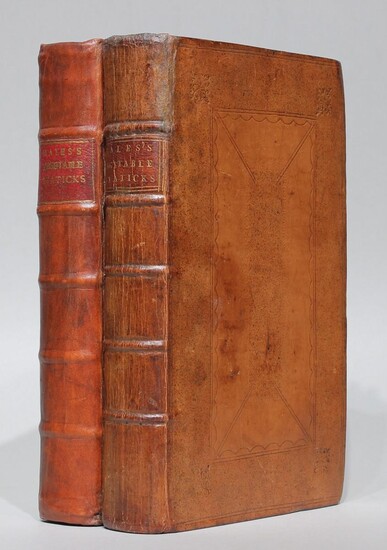Vegetable Staticks; or, an account of some Statical Experiments on the Sap in Vegetables / Statical Essays: containing haemastaticks; or, an Account of some Hydraulick and Hydrostatical Experiments made on the Blood and Blood-Vessels of Animals.
By HALES, Stephen
I: Vegetable Staticks; or, an account of some Statical Experiments on the Sap in Vegetables. Also . . . an Attempt to analyse the Air, by a great Variety of Chymio-Statical Experiments. - II: Statical Essays: containing haemastaticks; or, an Account of some Hydraulick and Hydrostatical Experiments made on the Blood and Blood-Vessels of Animals.; Also an Account of some Experiments on Stones in the Kidneys and Bladder. London: for W. Innys and R. Manby, and T. Woodward. 1727, (7) vii (2) 376 pp., 19 engraved plates by S. Gribelin (Vol. I); 1733, xxii, (26), 361, (23) pp. (Vol. II). First editions, 8vo (20x14cm). Contemporary ink signature on title, endpapers a little browned and spotted, bookplate on front pastedown, contemp. panelled calf, rebacked with red morocco label, a little worming (Vol. I). Vol. II with the leaf before the title announcing the Royal Society's authorisation of publication, contemp. panelled calf, the backstrip with red morocco label and gilt lettering. ---- Dibner 26; Garrison-Morton 765 (Haemastaticks); Horblit 45a and 45b; Grolier Medicine 41; Heirs of Hippocrates 784; Henrey 777-78; NLM/Blake, p.194; Osler 1081; Waller 11527; Wellcome III, p.194; Norman 970; PMM 189 (1731-3 edition) - FIRST EDITION. Hales applied his training in biology and mathematics (including physics) to make important scientific investigations presented in these separately published volumes. The first volume, Vegetable staticks, Hales describes his investigations of plant physiology, including the movement of water in plants and determining the three factors of water movement: root suction, root pressure and leaf suction. He also established that plants lose water continuously during transpiration through leaves. His quantitative measurements of these phenomena enabled him to show the rate of transpiration varied with temperature. Hales established that plants do not have true circulation system, and developed techniques of measuring the varying growth rates in different plant structures. -- The second volume, or Haemastaticks, 'contains the studies on blood pressure which make Hales one of the founders of modern experimental physiology. The application of the principle of the pressure-gauge or manometer enabled him to measure blood pressure during the contraction of the heart. He computed the circulation rate and estimated the velocity of the blood in the veins, arteries and capillary vessels and by showing that the capillary vessels are liable to constriction and dilation he made an important contribution both to the study of physiology and the practice of the physician of today . Hales's work marked the greatest advance in the physiology of the circulation between Harvey and the introduction of the mercury manometer and other instruments for the measurement of blood pressure by J.L.M. Poiseuille in 1828' (PMM).
Published by: for W. Innys and R. Manby, and T. Woodward, London, 1727
Vendor: Milestones of Science Books
Buy Now on
By HALES, Stephen
I: Vegetable Staticks; or, an account of some Statical Experiments on the Sap in Vegetables. Also . . . an Attempt to analyse the Air, by a great Variety of Chymio-Statical Experiments. - II: Statical Essays: containing haemastaticks; or, an Account of some Hydraulick and Hydrostatical Experiments made on the Blood and Blood-Vessels of Animals.; Also an Account of some Experiments on Stones in the Kidneys and Bladder. London: for W. Innys and R. Manby, and T. Woodward. 1727, (7) vii (2) 376 pp., 19 engraved plates by S. Gribelin (Vol. I); 1733, xxii, (26), 361, (23) pp. (Vol. II). First editions, 8vo (20x14cm). Contemporary ink signature on title, endpapers a little browned and spotted, bookplate on front pastedown, contemp. panelled calf, rebacked with red morocco label, a little worming (Vol. I). Vol. II with the leaf before the title announcing the Royal Society's authorisation of publication, contemp. panelled calf, the backstrip with red morocco label and gilt lettering. ---- Dibner 26; Garrison-Morton 765 (Haemastaticks); Horblit 45a and 45b; Grolier Medicine 41; Heirs of Hippocrates 784; Henrey 777-78; NLM/Blake, p.194; Osler 1081; Waller 11527; Wellcome III, p.194; Norman 970; PMM 189 (1731-3 edition) - FIRST EDITION. Hales applied his training in biology and mathematics (including physics) to make important scientific investigations presented in these separately published volumes. The first volume, Vegetable staticks, Hales describes his investigations of plant physiology, including the movement of water in plants and determining the three factors of water movement: root suction, root pressure and leaf suction. He also established that plants lose water continuously during transpiration through leaves. His quantitative measurements of these phenomena enabled him to show the rate of transpiration varied with temperature. Hales established that plants do not have true circulation system, and developed techniques of measuring the varying growth rates in different plant structures. -- The second volume, or Haemastaticks, 'contains the studies on blood pressure which make Hales one of the founders of modern experimental physiology. The application of the principle of the pressure-gauge or manometer enabled him to measure blood pressure during the contraction of the heart. He computed the circulation rate and estimated the velocity of the blood in the veins, arteries and capillary vessels and by showing that the capillary vessels are liable to constriction and dilation he made an important contribution both to the study of physiology and the practice of the physician of today . Hales's work marked the greatest advance in the physiology of the circulation between Harvey and the introduction of the mercury manometer and other instruments for the measurement of blood pressure by J.L.M. Poiseuille in 1828' (PMM).
Published by: for W. Innys and R. Manby, and T. Woodward, London, 1727
Vendor: Milestones of Science Books



